Tribological Behavior of 3D-Printed Nanometer SiC and SiO2 Particle-Reinforced Polyamide 12 Composites by Selective Laser Sintering under Seawater Lubrication Condition
Abstract
1. Introduction
2. Materials and Methods
2.1. Material and Specimens
2.2. Seawater Absorption
2.3. Hardness Tests
2.4. Friction and Wear Tests
3. Results and Discussion
3.1. Seawater Absorption
3.2. Hardness Tests
3.3. Surface Characterization
3.4. Contact Angle
3.5. Analysis of Friction and Wear
3.6. Analysis of Wear Surface and Wear Mechanism
4. Conclusions
- (1)
- The addition of micron- and nano-SiC particles and nano-SiO2 particles could de-crease the sea water adsorption and contact angle, and increase the hardness for both dry and seawater condition.
- (2)
- The addition of micron- and nano-SiC particles can reduce the friction coefficient and the specimen printed by recycled powder increase friction coefficient slightly, but has negligible difference compared with the PA12 specimen. The addition of nano-SiO2 increases the friction coefficient.
- (3)
- The addition of micron- and nano-SiC particles and nano-SiO2 particles could increase the wear loss under seawater conditions. This might be because the reinforced particles were detached due to the lower resistance of the polymer matrix to hold them.
- (4)
- The specimen printed by recycled powder could increase the width and depth of the wear track, while the addition of nano-SiO2 particles could decrease the width and depth.
- (5)
- The wear mechanisms of the composite specimens are the result of the combined effect of fatigue wear and abrasive wear under seawater conditions. The latter plays a dominant role. The Silicon content of the inside of the wear track is much lower compared with the outside of wear track for all the specimens. This might be because some of the SiC particles are worn off or buried in the gaps of asperity boundaries.
Author Contributions
Funding
Institutional Review Board Statement
Informed Consent Statement
Data Availability Statement
Conflicts of Interest
References
- Wang, J.; Yan, F.Y.; Xue, Q.J. Tribological behaviors of some polymeric materials in sea water. Chin. Sci. Bull. 2009, 54, 4541–4548. [Google Scholar] [CrossRef]
- Haq, M.I.U.; Raina, A.; Vohra, K.; Kumar, R.; Anand, A. An Assessment of Tribological Characteristics of Different Materials under Sea Water Environment. Mater. Today Proc. 2018, 5, 3602–3609. [Google Scholar] [CrossRef]
- Jun, C.; Yan, F. Tribocorrosion behaviors of Ti–6Al–4V and Monel K500 alloys sliding against 316 stainless steel in artificial seawater. Trans. Nonferrous Met. Soc. China 2012, 22, 1356–1365. [Google Scholar]
- Jun, C.; Zhang, Q.; Li, Q.; Fu, S.-L.; Wang, J.-Z. Corrosion and tribocorrosion behaviors of AISI 316 stainless steel and Ti6Al4V alloys in artificial seawater. Trans. Nonferrous Met. Soc. China 2014, 24, 1022–1031. [Google Scholar]
- Zhu, Y.; Liu, H.; Zhang, D.; Wang, J.; Yan, F. Effect of polarization potentials on tribocorrosion behavior of Monel 400 alloy in seawater environment. Tribol. Int. 2022, 168, 107445. [Google Scholar] [CrossRef]
- Wang, H.B.; Yang, D.Z.; Wu, G.J. Material and design of water lubricated bearing. Lubr. Eng. 2002, 151, 82–84. (In Chinese) [Google Scholar]
- Sumer, M.; Unal, H.; Mimaroglu, A. Evaluation of tribological behavior of PEEK and glass fibre reinforced PEEK composite under dry sliding and water lubricated conditions. Wear 2008, 265, 1061–1065. [Google Scholar] [CrossRef]
- Wypych, G. Handbook of Polymers; Elsevier: Amsterdam, The Netherlands, 2016. [Google Scholar]
- Roppenecker, D.B.; Grazek, R.; Coy, J.A.; Irlinger, F.; Lueth, T.C. Friction coefficients and surface properties for laser sintered parts. In Proceedings of the International Mechanical Engineering Congress and Exposition, San Diego, CA, USA, 15–21 November 2013; American Society of Mechanical Engineers: New York, NY, USA, 2013; Volume 56185, p. V02AT02A009. [Google Scholar]
- Wörz, A.; Drummer, D. Tribological anisotropy of selective laser sintered PA12 parts. Polym. Test. 2018, 70, 117–126. [Google Scholar] [CrossRef]
- Aldahash, S.A. Friction and wear properties of oriented Polyamide 12 objects manufactured by SLS Technology. J. Eng. Appl. Sci. 2021, 8, 28–36. [Google Scholar] [CrossRef]
- Kundera, C.; Kozior, T. The influence of selective laser sintering parameters on tribological properties of PA 3200 GF polyamide. Tribologia 2018, 277, 63–69. [Google Scholar] [CrossRef]
- Bai, J.; Song, J.; Wei, J. Tribological and mechanical properties of MoS2 enhanced polyamide 12 for selective laser sintering. J. Mater. Process. Technol. 2019, 264, 382–388. [Google Scholar] [CrossRef]
- Yu, G.; Ma, J.; Li, J.; Wu, J.Q.; Yu, J.; Wang, X.Z. Mechanical and Tribological Properties of 3D Printed Polyamide 12 and SiC/PA12 Composite by Selective Laser Sintering. Polymers 2022, 14, 2167. [Google Scholar] [CrossRef]
- Xie, G.Y.; Zhuang, G.S.; Sui, G.X.; Yang, R. Tribological behavior of PEEK/PTFE composites reinforced with potassium titanate whiskers. Wear 2010, 268, 424–430. [Google Scholar]
- Chen, B.; Wang, J.; Yan, F. Comparative investigation on the tribological behaviors of CF/PEEK composites under seawater lubrication. Tribol. Int. 2012, 52, 170–177. [Google Scholar] [CrossRef]
- Chen, B.; Wang, J.; Liu, N.; Yan, F.Y. Synergetic effect of lubricant additive and reinforcement additive on the tribological behaviors of PEEK-based composites under seawater lubrication. Tribol. Trans. 2013, 56, 672–680. [Google Scholar] [CrossRef]
- Zhang, Z.; Nie, S.; Yuan, S.; Liao, W. Comparative Evaluation of Tribological Characteristics of CF/PEEK and CF/PTFE/Graphite Filled PEEK Sliding against AISI630 Steel for Seawater Hydraulic Piston Pumps/Motors. Tribol. Trans. 2015, 58, 1096–1104. [Google Scholar] [CrossRef]
- Besnea, M.A.C.; Trufasu, D.C.; Andrei, G.; Bastiurea, M.; Rodeanu, M.S. Estimation of wear behavior of polyphenylene sulphide composites reinforced with glass/carbon fibers, graphite and polytetrafluoroethylene, by pin-on-disc test. Tribol. Ind. 2015, 37, 88. [Google Scholar]
- Xu, Y.; Guo, Y.; Li, G.; Zhang, L.; Zhao, F.; Guo, X.; Dmitriev, A.I.; Zhang, G. Role of hydrolysable nanoparticles on tribological performance of PPS-steel sliding pair lubricated with sea water. Tribol. Int. 2018, 127, 147–156. [Google Scholar] [CrossRef]
- Kamga, L.S.; Nguyen, T.-D.; Emrich, S.; Oehler, M.; Schmidt, T.; Gedan-Smolka, M.; Kopnarski, M.; Sauer, B. The effect of irradiated PTFE on the friction and wear behavior of chemically bonded PA46-PTFE-cb and PA66-PTFE-cb compounds. Wear 2022, 502–503, 204380. [Google Scholar] [CrossRef]
- Wang, J.; Yan, F.; Xue, Q. Tribological behavior of PTFE sliding against steel in sea water. Wear 2009, 267, 1634–1641. [Google Scholar] [CrossRef]
- Xie, W.; Pan, W.-P.; Chuang, K.C. Thermal characterization of PMR polyimides. Thermochim. Acta 2001, 367–368, 143–153. [Google Scholar] [CrossRef]
- Chen, J.; Jia, J.; Zhou, H.; Chen, J.; Yang, S.; Fan, L. Tribological behavior of short-fiber-reinforced polyimide composites under dry-sliding and water-lubricated conditions. J. Appl. Polym. Sci. 2007, 107, 788–796. [Google Scholar] [CrossRef]
- Chen, B.; Wang, J.; Liu, N.; Yan, F.Y. Synergism of several carbon series additions on the microstructures and tribological behaviors of polyimide-based composites under sea water lubrication. Mater. Des. 2014, 63, 325–332. [Google Scholar] [CrossRef]
- Qi, H.; Hu, C.; Zhang, G.; Yu, J.; Zhang, Y.; He, H. Comparative study of tribological properties of carbon fibers and aramid particles reinforced polyimide composites under dry and sea water lubricated conditions. Wear 2019, 436–437, 203001. [Google Scholar] [CrossRef]
- Min, C.; Nie, P.; Song, H.-J.; Zhang, Z.; Zhao, K. Study of tribological properties of polyimide/graphene oxide nanocomposite films under seawater-lubricated condition. Tribol. Int. 2014, 80, 131–140. [Google Scholar] [CrossRef]
- Xiong, D.; Ge, S. Friction and wear properties of UHMWPE/Al2O3 ceramic under different lubricating conditions. Wear 2001, 250, 242–245. [Google Scholar] [CrossRef]
- Xiong, D.; Gao, Z.; Jin, Z. Friction and wear properties of UHMWPE against ion implanted titanium alloy. Surf. Coat. Technol. 2007, 201, 6847–6850. [Google Scholar] [CrossRef]
- Shi, W.; Dong, H.; Bell, T. Tribological behavior and micronscopic wear mechanisms of UHMWPE sliding against thermal oxidation-treated Ti6Al4V. Mater. Sci. Eng. A 2000, 291, 27–36. [Google Scholar] [CrossRef]
- Dangsheng, X.; Jin, Z.M. Tribological properties of ion implanted UHMWPE against Si3N4 under different lubrication conditions. Surf. Coat. Technol. 2004, 182, 149–155. [Google Scholar] [CrossRef]
- Wang, J.; Yan, F.; Xue, Q. Friction and wear behavior of ultra-high molecular weight polyethylene sliding against GCr15 steel and electroless Ni–P alloy coating under the lubrication of seawater. Tribol. Lett. 2009, 35, 85–95. [Google Scholar] [CrossRef]
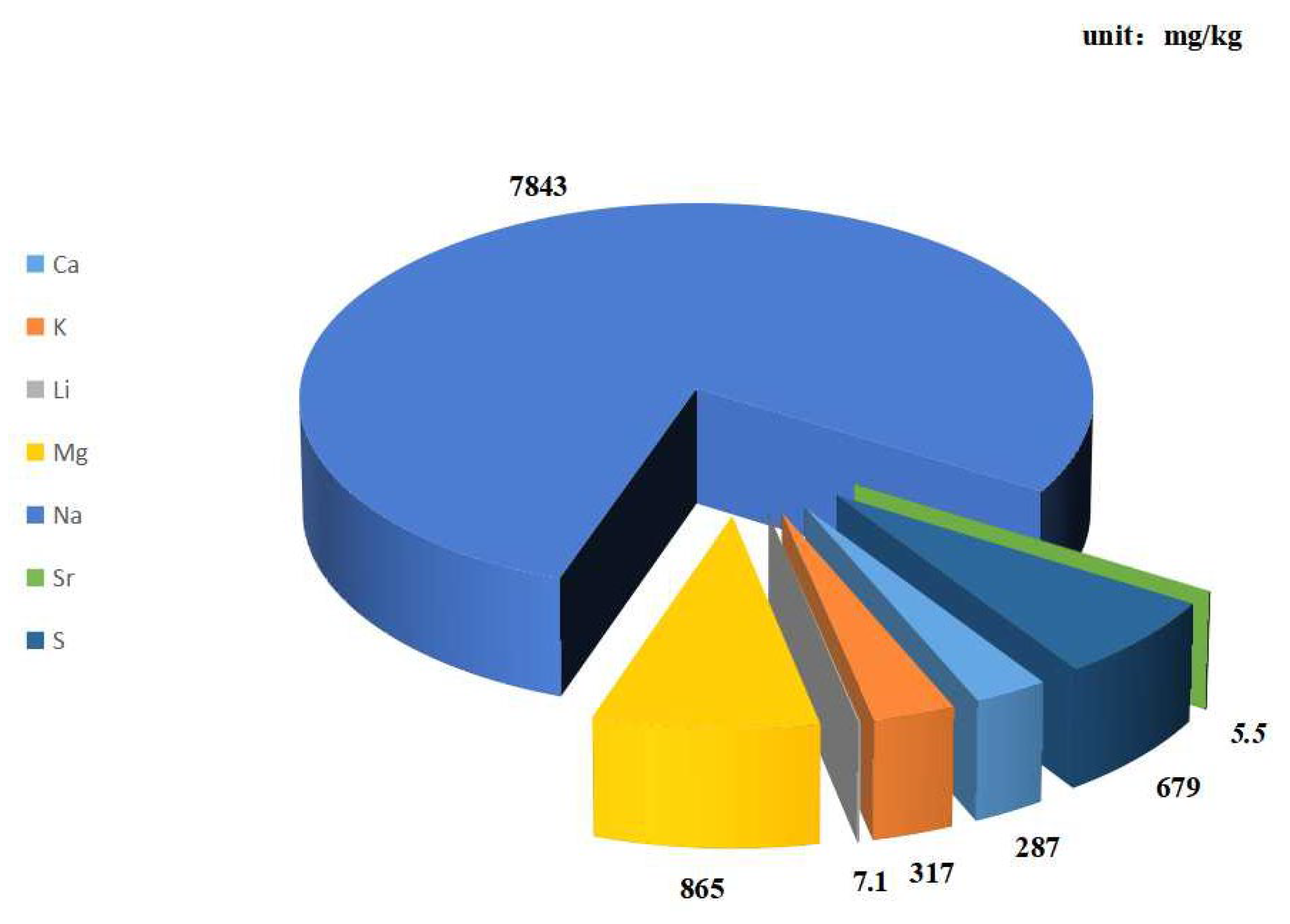


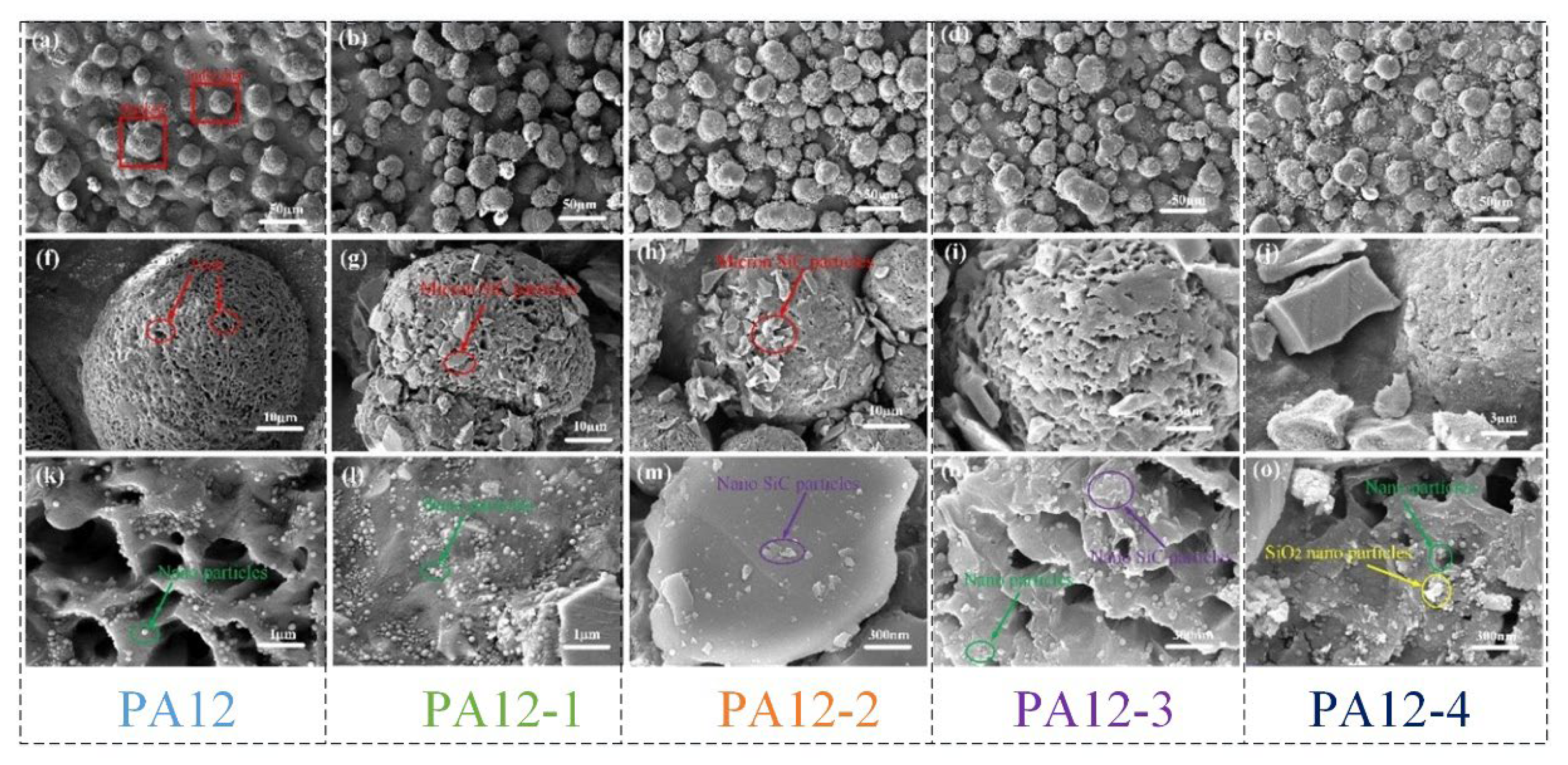
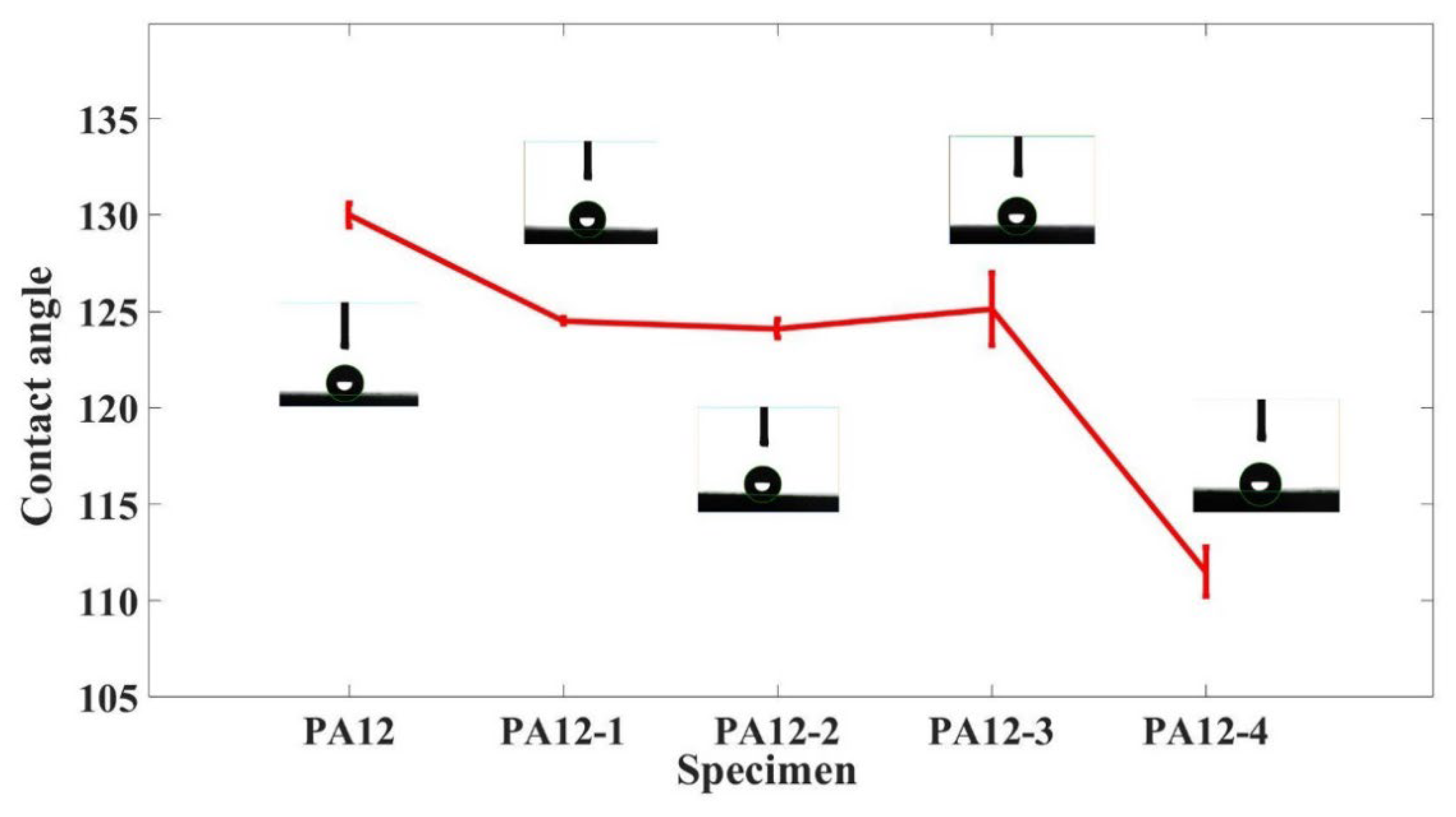
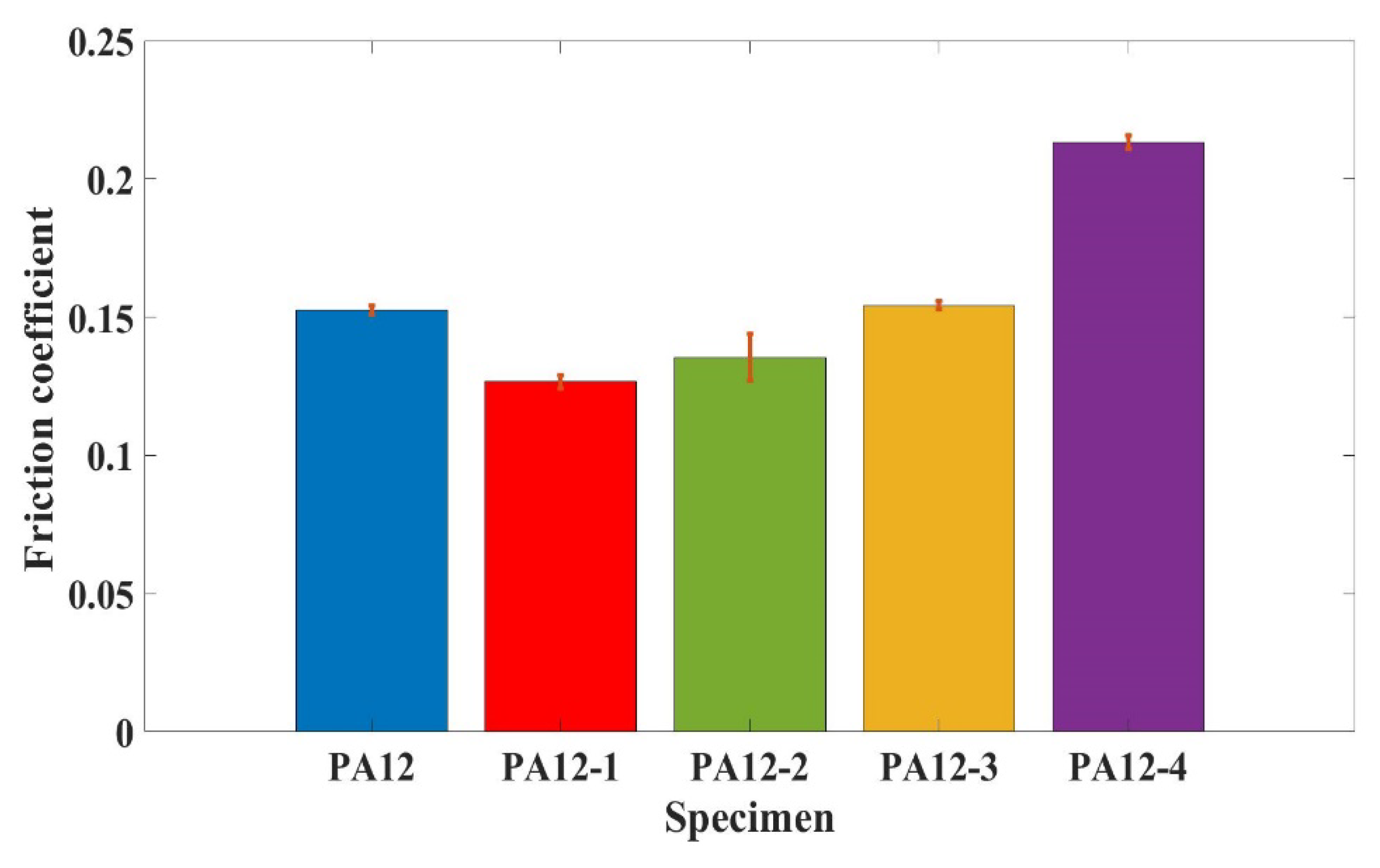
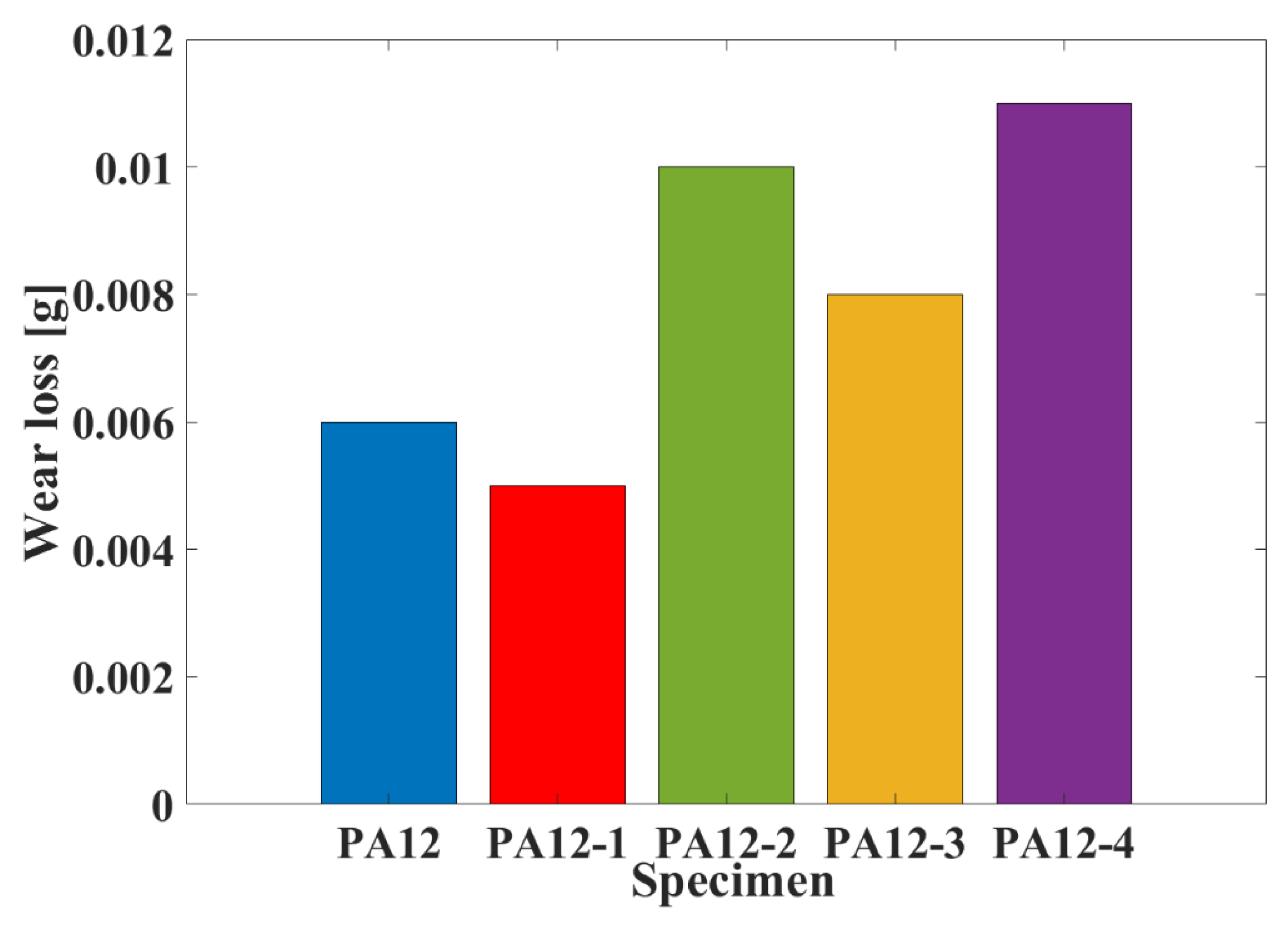

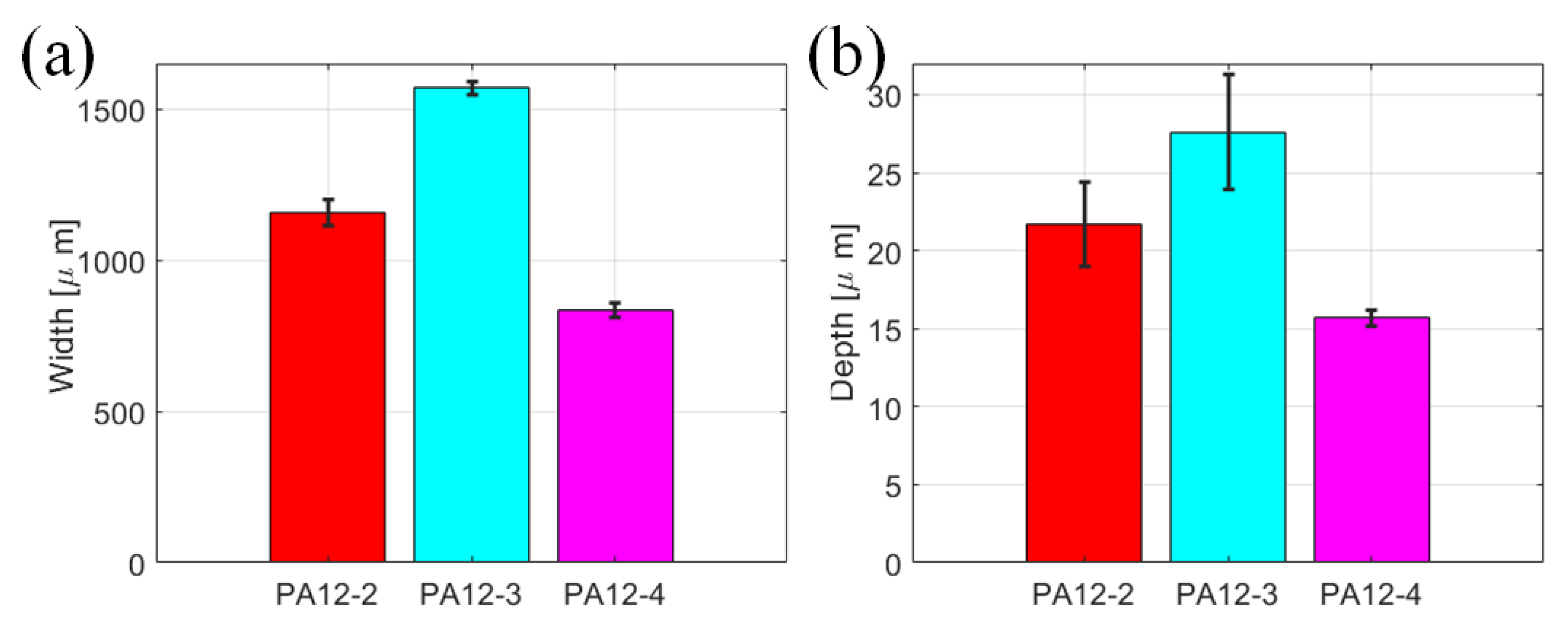
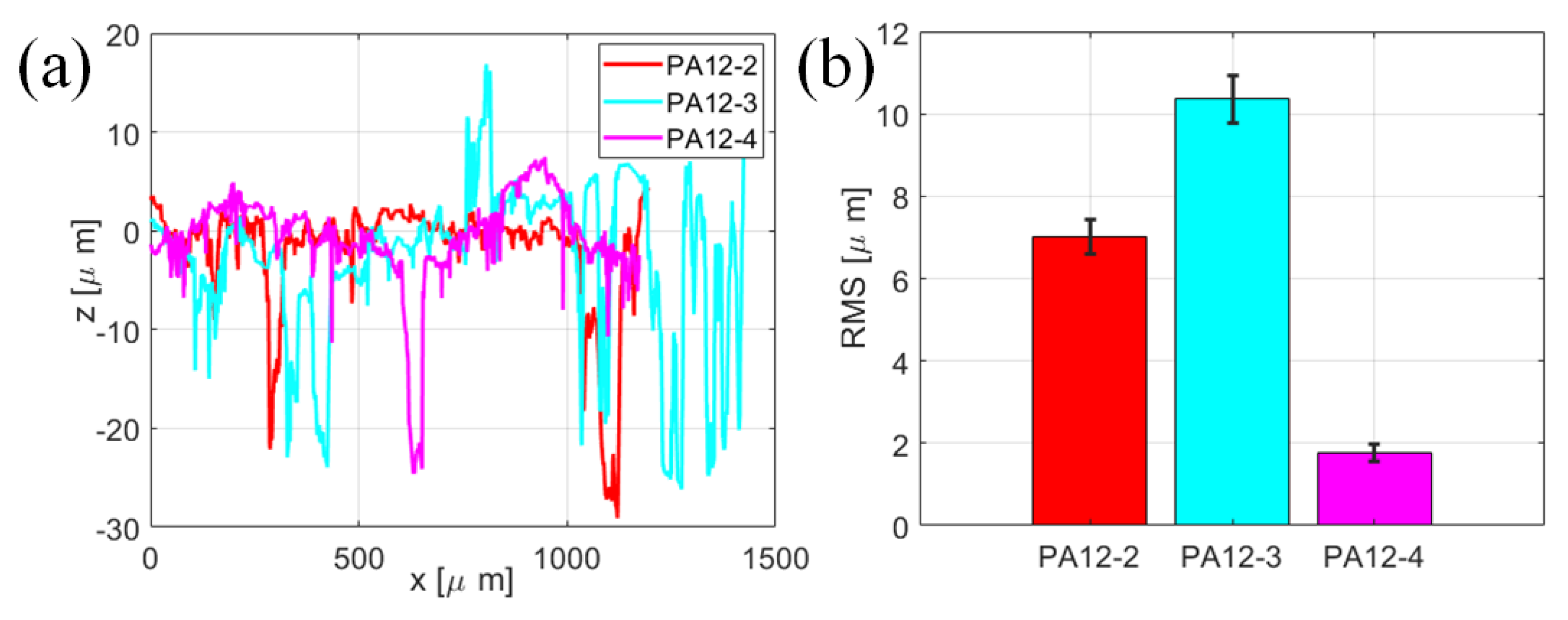
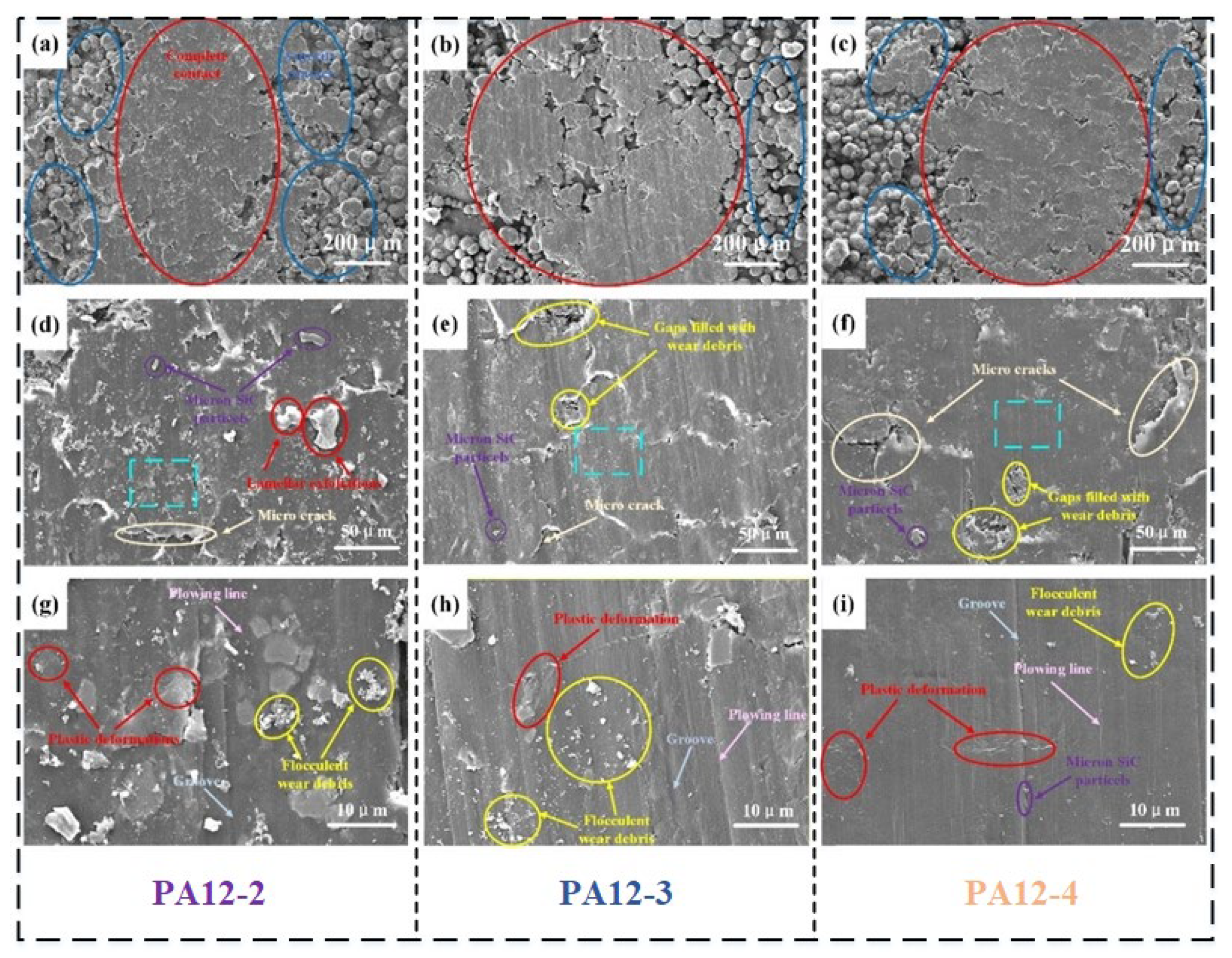

| Parameter | Preheated | Scanning Speed | Laser Power | Scanning Spacing |
|---|---|---|---|---|
| Value | 170 [°C] | 3000 [mm/s] | 10 W | 0.25 mm |
| Designation | Composition |
|---|---|
| PA12 | Neat PA12 |
| PA12-1 | PA12 Gew. 10 wt % micron-SiC |
| PA12-2 | PA12 Gew. 4 wt % micron-SiC + 2.5 wt.% nano-SiC |
| PA12-3 | PA12 Gew. 4 wt.% micron-SiC + 2.5 wt.% nano-SiC (recycled powder) |
| PA12-4 | PA12 Gew. 4 wt.% micron-SiC + 2.5 wt.% nano-SiC + 1 wt.% nano SiO2 |
Publisher’s Note: MDPI stays neutral with regard to jurisdictional claims in published maps and institutional affiliations. |
© 2022 by the authors. Licensee MDPI, Basel, Switzerland. This article is an open access article distributed under the terms and conditions of the Creative Commons Attribution (CC BY) license (https://creativecommons.org/licenses/by/4.0/).
Share and Cite
Ma, J.; Yu, G.; Wang, X.; Li, J.; Wu, J.; Wang, X. Tribological Behavior of 3D-Printed Nanometer SiC and SiO2 Particle-Reinforced Polyamide 12 Composites by Selective Laser Sintering under Seawater Lubrication Condition. Polymers 2022, 14, 4137. https://doi.org/10.3390/polym14194137
Ma J, Yu G, Wang X, Li J, Wu J, Wang X. Tribological Behavior of 3D-Printed Nanometer SiC and SiO2 Particle-Reinforced Polyamide 12 Composites by Selective Laser Sintering under Seawater Lubrication Condition. Polymers. 2022; 14(19):4137. https://doi.org/10.3390/polym14194137
Chicago/Turabian StyleMa, Jingdong, Guoyan Yu, Xianmin Wang, Jun Li, Jingquan Wu, and Xianzhang Wang. 2022. "Tribological Behavior of 3D-Printed Nanometer SiC and SiO2 Particle-Reinforced Polyamide 12 Composites by Selective Laser Sintering under Seawater Lubrication Condition" Polymers 14, no. 19: 4137. https://doi.org/10.3390/polym14194137
APA StyleMa, J., Yu, G., Wang, X., Li, J., Wu, J., & Wang, X. (2022). Tribological Behavior of 3D-Printed Nanometer SiC and SiO2 Particle-Reinforced Polyamide 12 Composites by Selective Laser Sintering under Seawater Lubrication Condition. Polymers, 14(19), 4137. https://doi.org/10.3390/polym14194137







